Cwmbach Llechryd is a small village situated about two miles north of Builth Wells, on the A470 main road to Newbridge-on-Wye, just inside the Radnorshire border. Within the Parish Church of St. John are two war memorials, which commemorate the men of the village who fell during both World Wars. Two of these men are buried in the Churchyard. The names on the memorial are not in alphabetical order, so I have re-arranged them for ease of reading.
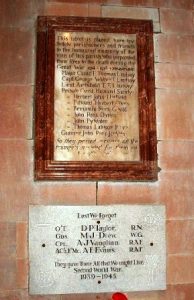
The Great War, 1914-1918
John Charles Bywater, Private, 40082, South Wales Borderers. John was the son of George Bywater and Alathea Bywater (nee Sheen), of Llyn, Disserth. He had married Margaret Williams in 1907, and the couple had four children. John enlisted at Knighton into the Monmouthshire Regiment, and after his training was posted to France, joining the 6th Battalion, South Wales Borderers, which was the Pioneer battalion to the 30th Division. He probably joined the battalion following the Divisions efforts on the Somme in 1916. In March 1917 the Division followed the German Retreat to the Hindenburg Line, and in April took part in the First and Second Battles of the Scarpe. Later that year the Division moved north to Ypres, and fought at the Battle of Pilckem. At the beginning of 1918 the Division was stationed near St. Quentin, and took part in heavy fighting following the German Spring Offensive of 21 March 1918. The depleted Division was then withdrawn from the line and moved to Flanders, but was caught up in the action again here when the Germans launched a fresh offensive along the Lys. The Division moved to the Aisne sector in May, and got caught up in another German offensive, the final one of the war. John was killed in action during heavy fighting near Hermonville on 28 May 1918, aged 32. He has no known grave and is commemorated on the Soissons Memorial, France.
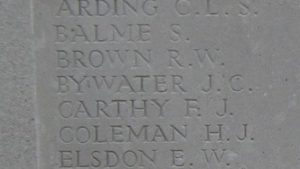
John Rees Davies, Private, 269540, Royal Engineers. John was born on 29 December 1877, the son of Isaac and Sarah Davies, of Oakfield House, Llanafon. He married Mary Samuel in 1901 and the couple set up home at 33, Wye View Terrace, Builth Road, where their two sons were born. John worked for the London and North Western Railway, at their engineering department at Builth Road prior to the war. He enlisted into the Royal Engineers and was posted to the 343rd Road Construction Company, RE in France. By the summer of 1917 John’s Company was attached to XIX Corps, at Ypres. The Third Battle of Ypres opened on 31 July 1917 and the Company would have been employed in building and repairing roads in order to keep the flow of men and material flowing to the front lines. He was wounded within a couple of days of the launching of the offensive and died of his wounds at the 17th Casualty Clearing Station, Lijssenthoek on 8 August 1917, aged 39. John is buried in Lijssenthoek Military Cemetery, Belgium.
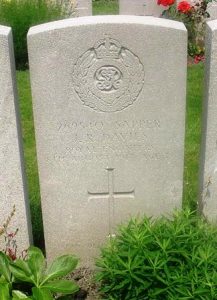
Benjamin Rees Gould, Private, 46407, Cheshire Regiment. Benjamin was the son of Benjamin and Mary Gould, of Tynllan, Disserth. He married Gertrude Mary Griffiths, of Newbridge-on-Wye, in 1912, and the couple lived at 1, Church Street, Builth Wells, where he worked as a gardener. Benjamin enlisted at Brecon into the Cheshire Regiment on 27 June 1916. He embarked at Southampton on 15 December 1916 and landed at Le Havre the following day, before joining the 22nd Battalion, Cheshire Regiment, a labour battalion. The battalion became the 65th Company, Labour Corps in April 1917, moving to Ypres. Benjamin was killed at Ypres on 19 June 1917, aged 28, while the Battle of Messines Ridge was raging. He was 28 years old and is buried in Poperinghe New Military Cemetery, Belgium.
Herbert John Hatfield, Private, 174600, Canadian Infantry. Herbert was born at Craven Arms on 19 April 1885, the son of James and Mary Hatfield. He worked as a railway fireman and lived at 14, Railway Terrace, Builth Road by 1911, but soon afterward emigrated to Canada. On 16 August 1915 Herbert enlisted at Lorenzo Dorse into the 86th Machine Gun Battalion, Canadian Infantry. He was medically examined at Hamilton, Ontario before embarking for England, sailing from Halifax aboard the SS Adriatic on 19 May 1916. On 22 October 1916 he arrived in France and was posted to the 5th Battalion, Canadian Infantry, which was attached to the 2nd Brigade, 1st Canadian Division. He probably saw action during the Divisions actions at the Battle of the Ancre Heights that month. The Division then moved to the Arras sector where it began to prepare for the forthcoming Battle of Arras the following year. The Canadian Corps was tasked with an assault against the heights of Vimy Ridge and on 9 April 1917 launched their attack, moving forwards through underground tunnels before scaling the heights and driving the Germans back. Herbert was wounded during the days fighting and was taken to the 6th Casualty Clearing Station, where he died on 10 April 1917, aged 32. He is buried in Barlin Communal Cemetery Extension, France.
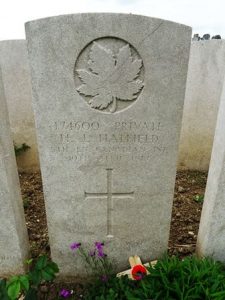
John Rees Jenkins, Gunner, 90923, Royal Garrison Artillery. John was the son of John and Esther Jenkins, of Troedrhiw, Cwmbach, Builth Road. He worked as a sorter at Builth Road prior to enlisting into the Royal Garrison Artillery on 11 December 1915, and was posted to the No. 1 Depot, RGA for training. On 1 December 1916 he was posted to the 180th Heavy Battery, Royal Garrison Artillery, at Winchester, and embarked for Salonika with the battery soon afterwards. John served in Salonika for the remainder of the war, fighting a tough battle against the Bulgarian troops who had invaded Greece in 1915 following the defeat of the Serbs. He survived the war but became ill and died of broncho-pneumonia on 1 January 1919, aged 24. He is buried in Mikra British Cemetery, Kalamaria, Greece.
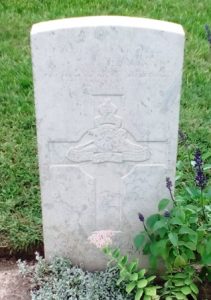
Archibald Thurston Thomas Lindsay, Lieutenant, Royal Monmouthshire Royal Engineers. Archibald was born on 17 June 1897, the son of Lieutenant Colonel Henry Edzell Morgan Lindsay and Ellen Katherine Lindsay (nee Thomas), of Ystrad Fawr, Ystradmynach, and of Pencerrig, Cwmbach. He was educated at Wellington College before being commissioned into his fathers’ regiment, the Royal Monmouthshire Royal Engineers in 1914 and was posted to France with the 7th Army Troops Company, Royal Monmouthshire Royal Engineers on 26 October 1915. He served on the Western Front with the unit for over two years before being killed by a sniper near Hébuterne, on the Somme, on 26 March 1918, aged 20. Archibald is buried in Foncquevillers Military Cemetery, France. His two brothers also fell during the war.
Claud Frederic Thomas Lindsay, MiD, Captain, Royal Field Artillery. Claud was born on 20 January 1892, the son of Lieutenant Colonel Henry Edzell Morgan Lindsay and Ellen Katherine Lindsay (nee Thomas), of Ystrad Fawr, Ystradmynach, and of Pencerrig, Cwmbach. He was educated at Wellington College before being commissioned into the Royal Artillery in 1912. He landed in France with the 120th Battery, 27th Brigade, Royal Field Artillery on 18 August 1914 and would have taken part in the Battle of Mons and the subsequent retreat to the Marne, before moving to Ypres with the BEF. In 1915 he returned home for a short spell of leave and married Dorothy Lindsay Forde, before returning to France. By the start of 1918 he had been promoted Captain and Mentioned in Despatches and was on the Somme attached to the 33rd Battery, Royal Field Artillery. His battery saw heavy fighting following the German Spring Offensive which was launched on 21 March 1918 and took part in the fighting withdrawal which followed. Claud was killed in action at the head of his battery near Domart on 31 March 1918, aged 26. He is buried in Hailles Communal Cemetery, France. His two brothers also fell during the war.
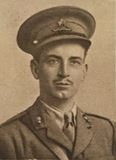
George Walter Thomas Lindsay, Captain, Royal Flying Corps. George was born on 29 January 1891, the son of Lieutenant Colonel Henry Edzell Morgan Lindsay and Ellen Katherine Lindsay (nee Thomas), of Ystrad Fawr, Ystradmynach, and of Pencerrig, Cwmbach. He was educated at Wellington College before being commissioned into the Royal Artillery in 1912. He embarked for France in August 1914 and had been wounded by a sniper at Ypres later in the year, before returning to duty. George then volunteered to serve with the Royal Flying Corps and was posted to 62 Squadron, RFC after training as a pilot. On 26 June 1917 George was flying a Royal Aircraft Factory B.E.2d., Serial 5816, from Filton, when the aircraft lost control and spun into the ground from 3,000 feet, killing George and his Air Mechanic, Airman Charles Edward Sharman. A witness reported that he thought a longeron on the front of the tail plane had failed. George was 26 years old when he was killed that day and was buried in the family vault at Holy Trinity Churchyard, Ystrad Mynach.
Edward Herbert Owen, Private, 24411, Welsh Regiment. Edward was the son of Moses and Mary Ann Owen, of 40, Wyeview Terrace, Builth Road, Breconshire. He enlisted at Cwmgorse into the 16th Battalion, Welsh Regiment, which was the Cardiff City battalion, attached to 115 Brigade, 38th (Welsh) Division. The Division landed in France in December 1915, and was initiated into trench warfare at Fleurbaix for several months, before moving to the Somme in June 1916, and fighting at Mametz Wood. The Division then moved to Ypres, and held the line at Boesinghe for the next twelve months. Edward was killed while the 16th Welsh were working on the Canal Bank at Boesinghe on 19 June 1917. He was 21 years old, and is buried at Poperinghe New Military Cemetery, Belgium.
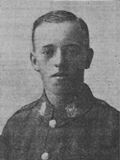
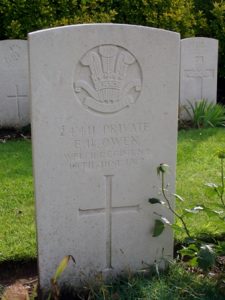
Thomas Lawson Price, Private, M/403776, Royal Army Service Corps. Thomas was the son of William and Anne Price, of Glangwy Farm, Builth Road. He had enlisted into the Motor Transport section of the Army Service Corps on 2 March 1916 and served in France until being discharged as medically unfit on 6 January 1919, returning home to Glangwy Farm. His health deteriorated quickly after being discharged and Thomas died at home on 18 March 1919, aged 20. He was buried in St. John’s Churchyard, Cwmbach Llechryd.
Cyril Howard Sandy, Private, 43885, Welsh Regiment. Cyril was the son of Oliver and Margaret Sandy, of 19, Wye View Terrace, Builth Road. He enlisted at Builth Wells into the Welsh Regiment and was posted to the 18th Battalion, Welsh Regiment, which was attached to 119 Brigade, 40th (Bantam) Division. The Division moved to France during the first week of June 1916, and moved to the front near Loos. Late in 1916 the Division moved south to the Somme, and fought at the Battle of the Ancre. Following the closure of the Somme offensive, the Division wintered in the same sector and on 30 December 1916 were in billets at Camp 17, at Suzanne, in the Somme Valley, when a German artillery shell struck a nearby French ammunition dump, causing a huge explosion. The 18th Welsh suffered eight men killed and nineteen more wounded as a result of this. The men were all buried together at Priez Farm Cemetery, Combles, but following further fighting in the area over the coming twelve months, the graves were lost and all the men are now commemorated by Special Memorials in Guards’ Cemetery, Combles, France.
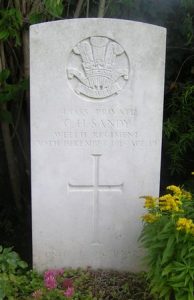
World War Two, 1939-1945
Morley James Drew, Guardsman, 2737342, Welsh Guards. Morley was the son of Owen and Gladys Ruth Drew, of Builth Road. He enlisted into the 3rd Battalion, Welsh Guards. The battalion was formed at Beavers Camp, Hounslow on the 24 October 1941, and sailed for North Africa on 5 February 1943, joining the 1st Guards Brigade. The battalion then took part in the drive to push Rommel out of North Africa before landing in Italy early in 1944. Here it took part in the drive to push the Germans out of Italy, seeing heavy fighting at Monte Cerasola before advancing towards Rome and seeing more fighting at Monte Piccolo before attacking the Gothic Line. Morley was killed in Italy on 26 July 1944, aged 30. He is buried in Assisi War Cemetery, Italy.
Alfred Edwards Evans, Aircraftman 2nd Class, 1279091, Royal Air Force Volunteer Reserve. Alfred was the son of Oscar Ralph Evans and Maud Evans (nee Smith), of 29, Wye View Terrace, Builth Road. He enlisted into the Royal Air Force Volunteer Reserve. Little else is known of him, but Alfred died in the South Wales Sanatorium, Bronllys on 27 September 1943, aged 22. He is buried in St. John’s Churchyard, Cwmbach Llechryd.
Douglas Percy Taylor, Telegraphist, D/JX 454425, Royal Navy. Douglas was born on 21 December 1924, the son of Percy Frederick Taylor and Dorothy May Taylor, of 41, Wye View Terrace, Builth Road. He enlisted into the Royal Navy and was posted aboard H.M.L.C.T. (R) 457. She was a converted Landing Craft which had been converted to carry an impressive 1,044 5-inch rockets, which could be fired electronically, in banks, and had been used to support the Normandy landings on D-Day. She sailed from England again on 27 October 1944 to Ostend as part of the Support Squadron Eastern Flank, which was a large force despatched to land Commandos at Antwerp, to secure the port. The assault went in on 1 November. On four days later, 5 November 1944, Douglas was aboard H.M.L.C.T. (R) 457, which had been despatched to fire on German positions at Walcheren, but she struck a German mine off Ostend and sank. Douglas was 19 years old when he died during the sinking and is commemorated on the Plymouth Naval Memorial, Devon.
Alfred John Vaughan, Corporal, 540407, Royal Air Force. Alfred was the son of George Thomas Vaughan and Annie Jane Vaughan (nee Edwards), of Builth Road, Radnorshire. He married Lilian Vera Vaughan Davies at Nuneaton in 1941 after having enlisted into the Royal Air Force. Alfred was posted to North Africa, and died in hospital in Egypt on 28 October 1944, aged 25. He is buried in Alexandria (Chatby) Military and War Memorial Cemetery, Egypt.